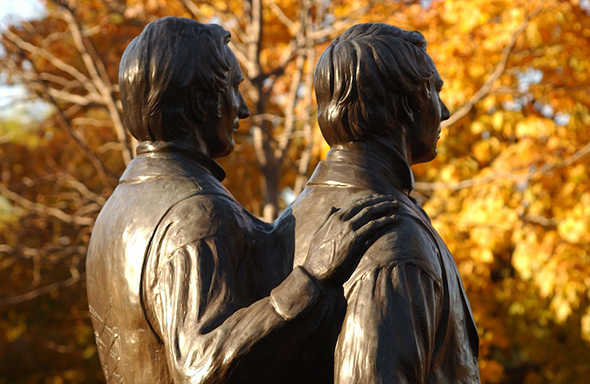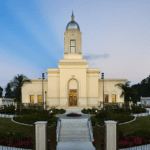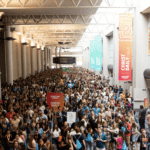Greater love hath no man than this, that a man lay down his life for his friends.
John 15:13
Finding Joseph’s Gun
In the Church History Museum near Temple Square, located inside a glass case, resides a pair of 19th century pistols and a walking stick. The placard reads, in part, as follows,
Joseph’s Pepperbox Pistol and Hyrum’s Single Shot Pistol. These guns were used by both men for their defense during the attack at Carthage
These were the guns that were smuggled into the Carthage Jail while Joseph Smith, Hyrum and their friends awaited their fate. On the morning of June 27, 1844, Cyrus Wheelock visited the jail.
The morning being a little rainy, favoured his wearing an overcoat, in the side pocket of which he was enabled to carry a six-shooter, and he passed the guard unmolested. During his visit in the prison he slipped the revolver into Joseph’s pocket. Joseph examined it, and asked Wheelock if he had not better retain it for his own protection.
This was a providential circumstance, as most other persons had been very rigidly searched. Joseph then handed the single barrel pistol, which had been given him by John S. Fullmer, to his brother Hyrum, and said, “You may have use for this.” Brother Hyrum observed, “I hate to use such things, or to see them used.” “So do I,” said Joseph, “but we may have to, to defend ourselves;” upon this Hyrum took the pistol. [i]
Although it was referred to as a “six shooter,” the pepper-box pistol was not a revolver in the normal sense. It incorporated six individual barrels, it was difficult to aim and tended to be unreliable. The June 2013 Ensign features a painting Greater Love Hath No Man, by Casey Childs. [ii] The artwork features all three items in the display case. Joseph, Hyrum and Willard Richards are attempting to hold the door shut as the mob attempts to enter the room. John Taylor is holding his walking stick. In Hyrum’s left pocket is the single shot pistol brought into the jail by Fullmer, and in Joseph’s left pocket, clearly visible, is the pepper-box pistol given to him by Wheelock. [iii]
Firing Joseph’s Gun
The attack commenced with Hyrum being shot in the face through the door. Hyrum’s pistol was never fired. Willard Richards wrote,
As he struck the floor he exclaimed emphatically; “I’m a dead man.” Joseph looked towards him and responded, “O dear! Brother Hyrum!” and opening the door two or three inches with his left hand, discharged one barrel of a six shooter (pistol) at random in the entry from whence a ball grazed Hyrum’s breast, and entering his throat passed into his head, while other muskets were aimed at him, and some balls hit him. [iv]
Joseph, grief stricken upon seeing the death of his brother, pulled the pepperbox from his pocket, reached around the door frame and blindly attempted to discharge all six rounds from his pistol into the group of men that was attempting to push their way into the room. Only three of the rounds actually fired, but the intruders at the door were packed so closely together that Joseph could not possibly miss. All three of the rounds fired by Joseph apparently found targets, and John Taylor later mistakenly believed that two of the men struck had actually died from their wounds. Taylor wrote that Joseph, “with a firm, quick step, and a determined expression of countenance, approached the door, and pulling the six-shooter left by Brother Wheelock from his pocket, opened the door slightly, and snapped the pistol six successive times; only three of the barrels, however, were discharged. I afterwards understood that two or three were wounded by these discharges, two of whom, I am informed, died.” [v]
The information given to John Taylor was in error, however. Dallin Oaks and Marvin Hill talk of the three men wounded by Joseph.
There were separate indictments for the two murders. Each charged the same nine defendants: John Wills, William Voras….and two men named Gallaher and Allen, whose first names were not given….Wills, Voras, and Gallaher were probably named in the indictment because their wounds, which testimony showed were received at the jail, were irrefutable evidence that they had participated in the mob. They undoubtedly recognized their vulnerability and fled the county. A contemporary witness reported these three as saying that they were the first men at the jail, that one of them shot through the door killing Hyrum, that Joseph wounded all three with his pistol, and that Gallaher shot Joseph as he ran to the window. [vi]
The only men known to have been wounded in the attack would be those on the receiving end of Joseph’s pistol. Dead men, of course, are not indicted, nor do they flee the county.
Talking of Joseph’s Gun
As a missionary in 1979, I often used a filmstrip projector. One of the filmstrips that we often showed to investigators was called “The Martyrdom.” The audio tape accompanying the filmstrip stated that Cyrus Wheelock smuggled a pistol into Carthage Jail and gave it to Joseph. The final frame of the filmstrip ended with Joseph’s testimony, now found in Doctrine and Covenants 76:22-23.
And now, after the many testimonies which have been given of him, this is the testimony, last of all, which we give of him: That he lives! For we saw him, even on the right hand of God; and we heard the voice bearing record that he is the Only Begotten of the Father.
Joseph’s use of a gun at the time of the martyrdom was simply part of the story. There was no particular emphasis made of it, nor was there any attempt to diminish the fact that Joseph fired at his attackers. Yet I have spoken with returned missionaries today who are completely unaware that Joseph even had a gun at Carthage Jail. Have references to Joseph’s gun disappeared from Church materials?
A search of lds.org produces a detailed description in the 2003 Church History in the Fulness of Times manual. The manual’s explanation is in accordance with my memory of the filmstrip that I viewed so many years ago,
At the jail, the four brethren sweltered in the sultry afternoon heat. Joseph gave Hyrum a single-shot pistol and prepared to defend himself with the six-shooter smuggled in that morning by Cyrus Wheelock. . . . A bullet fired through the panel of the door struck Hyrum in the left side of his face, and he fell, saying, “I am a dead man!” Joseph, leaning over Hyrum exclaimed, “Oh dear, brother Hyrum!” John Taylor said the look of sorrow he saw on Joseph’s face was forever imprinted on his mind. Joseph then stepped to the door, reached around the door casing, and discharged his six-shooter into the crowded hall. Only three of the six chambers fired, wounding three assailants. [vii]
A picture of the two pistols appears in the manual with the following description:
The Prophet used this six-shooter, called a “pepper-box,” to defend himself and his fellow prisoners.
John S. Fullmer took this single-barrel pistol into the jail, but it was never used by the prisoners. [viii]
But that is not all. The Gospel Doctrine Teacher’s Manual for 2005: “Doctrine and Covenants and Church History” lesson 32, page 184 has the following account of the martyrdom by Elder Willard Richards:
As he struck the floor he exclaimed emphatically, I am a dead man.’ Joseph looked towards him and responded, Oh, dear brother Hyrum!’ and opening the door two or three inches with his left hand, discharged one barrel of a six shooter (pistol) at random in the entry. . .Joseph continued snapping his revolver round the casing of the door into the space as before, while Mr. Taylor with a walking stick stood by his side and knocked down the bayonets and muskets which were constantly discharging through the doorway….
When the revolver failed, we had no more firearms, and expected an immediate rush of the mob, and the doorway full of muskets, half way in the room, and no hope but instant death from within.
Thomas S. Monson in the First Presidency Message of the June 1994 Ensign, notes that “the Prophet Joseph, with his pistol in hand, was attempting to defend his life and that of his brethren.” [ix]
There does not seem to be any lack of reference to the pistol or the manner in which it was used in current Church materials. Additional accounts are found in the Times and Seasons, the History of the Church, and the video The Joseph Smith Papers, The Martyrdom Of Joseph And Hyrum Smith – Episode 49.[x]
Why did the Saints feel the need to defend themselves?
Why would Joseph and those with him feel that they needed to have weapons to defend themselves? In order to understand this, it is necessary to understand why Joseph ended up in jail in the first place.
The event that landed Joseph in jail was the order of the Nauvoo City council to destroy the printing press of the Nauvoo Expositor. The editors of the Expositor, among whom was former First Presidency member William Law, made the intentions of the paper very clear:
We are earnestly seeking to explode the vicious principles of Joseph Smith, and those who practice the same abominations and whoredoms; which we verily know are not accordant and consonant with the principles of Jesus Christ and the Apostles.” [xi]
The Expositor called for the “unconditional repeal of the Nauvoo City charter, and encouraged members of the Church to reject Joseph Smith as its leader, noting that:
We hereby notify all those holding licenses to preach the gospel, who know they are guilty of teaching the doctrine of other Gods above the God of this creation; the plurality of wives; the unconditional sealing up against all crimes, save that of shedding innocent blood; the spoiling of the gentiles, and all other doctrines, (so called) which are contrary to the laws of God , or to the laws of our country, to cease preaching.” [xii]
The publication of the Expositor incited “anger and fear in Nauvoo: anger for its vilification of the Prophet and its accusations against other Church leaders; fear from its call for a repeal of the Nauvoo charter so that local government would be taken out of the hands of the Saints.” [xiii]
Thus, the paper was declared a “nuisance” by the Nauvoo City council, and the press was subsequently destroyed. This ultimately resulted in Joseph being brought up on charges of treason, and his subsequent trip to Carthage to await trial.
“Let it be made with powder and ball!!!”
Was the mob that stormed the jail that day doing so because they were each outraged over an apparent attack on freedom of the press? Not really. The destruction of the Expositor was simply a trigger, and it was used as leverage to great effect. The Expositor was destroyed on June 10, 1844. The following day, Thomas B. Sharp, editor of the Warsaw Signal, printed an editorial titled simply “The Time has Come!”
War and extermination is inevitable! Citizens ARISE, ONE and ALL!!!-Can you stand by, and suffer such INFERNAL DEVILS! to ROB men of their property and RIGHTS, without avenging them. We have no time for comment, every man will make his own. LET IT BE MADE WITH POWDER AND BALL!!! [xiv]
In Sharp’s mind, the “time had come” to deal with Joseph Smith and the Mormons. Things did not reach this level simply because of the Expositor. On June 5, the week before the destruction of the Expositor, Sharp had published a diatribe against Joseph,
Joe, you are [the] very thing you accuse Messrs. Van Buren, Clay and Calhoon of being; and more, we do not believe that even your blackguard pen, or rather that of your man Friday’s, (for no one would accuse you of being able to put two sentences in the English Language together correctly,) can picture a wretch so depraved, and loathsome as yourself. Yos Joe! we have that confidence in your saintship, that we do not believe that the concentrated extract of all the abominations of the Infernal Regions, can add one stain to the blackness of your character. Look in a mirror Joe and you will see the reflection of the most detestable wretch that the earth contains. [xv]
The tinder had already been laid, and the destruction of the Expositor was the match that ignited it. It is no surprise that Joseph and those who supported him would feel the need to provide some defense against a possible armed attack.
Does Joseph qualify as a martyr?
There is no doubt that Joseph attempted to defend himself and his friends using a firearm, and that this is attested to abundantly within Church publications. Does this mean that he does not qualify as a “martyr”? Joseph said, “I am going like a lamb to the slaughter; but I am calm as a summer’s morning; I have a conscience void of offense towards God, and towards all men. I shall die innocent, and it shall yet be said of me-he was murdered in cold blood.” [xvi] Did Joseph lose martyr status when he attempted to fight back?
Critics of the Church chose to portray the martyrdom as a “gun battle” between Joseph and those who were trying to enter the room. The term “gun battle” evokes a certain mental image, often fueled by depictions in movies, of an intense back-and-forth exchange of shots. It is not usually represented by a few individuals trapped in a room, desperately trying to keep themselves from being murdered. Joseph’s group had two pistols and a walking stick against a large, well-armed mob. Joseph firing off three shots at his attackers after witnessing the murder of his brother hardly constitutes a “gun battle,” and Joseph no doubt knew that it would make little difference. What effect did the presence of Joseph’s gun have on the attackers? It was no doubt a temporary deterrent, and it may have contributed to sparing the lives of John Taylor and Willard Richards, since the mob had no way of knowing if there were other weapons in the room as well.
What is more likely to have saved their lives, however, is Joseph choosing to go to the window. The mob focused on the true object of their murderous quest, and Taylor and Richard’s lives were spared.
The definition of “martyr,” according to Noah Webster’s 1828 dictionary is: “One who, by his death, bears witness to the truth of the gospel. Stephen was the first Christian martyr. To be a martyr signifies only to witness the truth of Christ.” [xvii]
John Taylor, who was seriously wounded in the attack and a firsthand witness to these events, certainly considered Joseph and Hyrum martyrs:
To seal the testimony of this book and the Book of Mormon, we announce the martyrdom of Joseph Smith the Prophet, and Hyrum Smith the Patriarch. They were shot in Carthage jail, on the 27th of June, 1844, about five o’clock p.m., by an armed mob-painted black-of from 150 to 200 persons. Hyrum was shot first and fell calmly, exclaiming: I am a dead man! Joseph leaped from the window, and was shot dead in the attempt, exclaiming: O Lord my God! They were both shot after they were dead, in a brutal manner, and both received four balls. [xviii]
Elder D. Todd Christofferson offers this perspective,
Martyrdom endows a prophet’s testimony with a special validity. Indeed the Greek root “martureo” from which the English word “martyr” is derived means “witness.” The prophet Abinadi is described as “having sealed the truth of his words by his death.” Jesus’ own death was a testament of His divinity and mission. He is declared in Hebrews to be “the mediator of the new testament” validated by His death, “For where a testament is, there must also of necessity be the death of the testator. For a testament is of force after men are dead.” [xix]
The fact that Joseph defended himself and his friends from those who were trying to kill them does not in any way diminish the importance of the sacrifice that Joseph and Hyrum ultimately made. Joseph had faced death before. Joseph and Hyrum had earlier had the opportunity to escape to Iowa, but instead chose to go to Carthage, knowing the probable outcome. This was not an act of cowardice. Joseph was no doubt aware that two pistols that they possessed in the jail would ultimately fail to hold back an armed mob.
Elder Christofferson states that Joseph’s death validated his testament:
Like most of the Lord’s anointed in ancient time, [Joseph Smith] sealed his mission and his works with his own blood.” In a hail of bullets on the afternoon of June 27, 1844, in Carthage, Illinois, Joseph and his brother, Hyrum, were cut down for the religion and testimony they professed. As the latter-day apostles then announced, “The testators are now dead, and their testament is in force.[xx]
Joseph knew that he might someday be required to die in order to seal his testament, and yet he knew also that Jesus Christ had made the ultimate sacrifice. The words of Doctrine and Covenants 122:7-9, which Joseph received during the many grueling months he spent in Liberty Jail, seem particularly appropriate. Joseph wanted to know if his ordeal would ever end, and the Lord gave him glimpse of the future, while reminding him of who made the true sacrifice:
And if thou shouldst be cast into the pit, or into the hands of murderers, and the sentence of death passed upon thee; if thou be cast into the deep; if the billowing surge conspire against thee; if fierce winds become thine enemy; if the heavens gather blackness, and all the elements combine to hedge up the way; and above all, if the very jaws of hell shall gape open the mouth wide after thee, know thou, my son, that all these things shall give thee experience, and shall be for thy good.
The Son of Man hath descended below them all. Art thou greater than he?
Therefore, hold on thy way, and the priesthood shall remain with thee; for their bounds are set, they cannot pass. Thy days are known, and thy years shall not be numbered less; therefore, fear not what man can do, for God shall be with you forever and ever. [xxi]
For further information regarding Joseph’s gun and the martyrdom, including an extensive list of Church publications which mention the weapon, please see the FairMormon Answers articles
[ii] Casey Childs, Greater Love Hath No Man, Oil on Linen, 60×48?. The artist has documented the meticulous process by which he created a historically accurate representation of the moment just before Hyrum was shot. This included researching the pistols that Joseph and Hyrum were carrying in their pockets.
[iii] LaRene Porter Gaunt, “Two Witnesses, Three Days And the Aftermath of the Martyrdom,” Ensign, June 2013, 40.
[vi] Oaks, Dallin H., and Marvin S. Hill. Carthage Conspiracy: The Trial of the Accused Assassins of Joseph Smith. Urbana: University of Illinois, 1975, 51-52.
[ix] Thomas S. Monson, “The Prophet Joseph Smith: Teacher by Example,” Ensign, June 1994.
[x] Times and Seasons, 5/14 (1 August 1844): 597-98; Joseph Smith, History of The Church of Jesus Christ of Latter-day Saints, 7 volumes, edited by Brigham H. Roberts, (Salt Lake City: Deseret Book, 1957), 7:102-103; The Joseph Smith Papers, The Martyrdom Of Joseph And Hyrum Smith – Episode 49
[xii] Nauvoo Expositor,
[xiii] “Highlights in the Prophet’s Life,” Ensign, June 1994.



















VinceNovember 12, 2013
It was a terrifying circumstance. Probably more going on than historical documents reveal. But it wasn't like a "Lamb to the Slaughter." Many would defend themselves in this situation. What does this say about the Mormon - NonMormon relationships. The level of violence on both sides? Has the cultural identity been washed over?
Rockgod28November 9, 2013
An armed mob raided a jail. They were sure Joseph was going to win his court case, again. They attacked the jail assuming their murder of Joseph would have been easy. Even Joseph thought the same thing. He defended himself and his friends that many forget were still in the room. One wounded badly. It is the greatest of ironies that Joseph and his brother had seven shots between them and out-numbered the guards. They did not run. They did not escape when they had the ability and weapons to do so easily. The irony is that they had to use a gun to keep the mob out of their cell. The martyrdom of Joseph Smith is also a reminder of how important liberty and justice is to everyone.